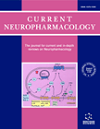- Home
- A-Z Publications
- Current Neuropharmacology
- Previous Issues
- Volume 12, Issue 3, 2014
Current Neuropharmacology - Volume 12, Issue 3, 2014
Volume 12, Issue 3, 2014
-
-
Protein Kinase C-Related Kinase (PKN/PRK). Potential Key-Role for PKN1 in Protection of Hypoxic Neurons
More LessAuthors: Bettina Thauerer, Stephanie zur Nedden and Gabriele Baier-BitterlichSerine/threonine protein kinase C-related kinase (PKN/PRK) is a family of three isoenzymes (PKN1, PKN2, PKN3), which are widely distributed in eukaryotic organisms and share the same overall domain structure. The Nterminal region encompasses a conserved repeated domain, termed HR1a-c as well as a HR2/C2 domain. The serine/threonine kinase domain is found in the C-terminal region of the protein and shows high Read More
-
-
-
The Glutamatergic Aspects of Schizophrenia Molecular Pathophysiology: Role of the Postsynaptic Density, and Implications for Treatment
More LessSchizophrenia is one of the most debilitating psychiatric diseases with a lifetime prevalence of approximately 1%. Although the specific molecular underpinnings of schizophrenia are still unknown, evidence has long linked its pathophysiology to postsynaptic abnormalities. The postsynaptic density (PSD) is among the molecular structures suggested to be potentially involved in schizophrenia. More specifically, the PSD is an el Read More
-
-
-
Multi-Target Directed Drugs: A Modern Approach for Design of New Drugs for the treatment of Alzheimer’s Disease
More LessAuthors: Kris Simone Tranches Dias and Claudio ViegasAlzheimer’s disease (AD) is a complex neurodegenerative disorder with a multi-faceted pathogenesis. So far, the therapeutic paradigm “one-compound-one-target” has failed and despite enormous efforts to elucidate the pathophysiology of AD, the disease is still incurable. The multiple factors involved in AD include amyloid aggregation to form insoluble neurotoxic plaques of Aβ, hyperphosphorylation of tau protein, oxid Read More
-
-
-
The Effectiveness of Dimethyl Fumarate Monotherapy in the Treatment of Relapsing-Remitting Multiple Sclerosis: A Systematic Review and Meta-Analysis
More LessAuthors: Pawel Kawalec, Alicja Mikrut, Natalia Wisniewska and Andrzej PilcBackground: Dimethyl fumarate (BG-12, Tecfidera®) is a new oral drug approved by FDA and EMA in March 2013 for relapsing – remitting multiple sclerosis (RRMS). The drug was much anticipated because of its possible superiority over currently available medications: fingolimod and teriflunomide as the only MS treatments currently available in oral form. Objective: The aim of this systematic review with meta-analysis Read More
-
-
-
Potential Effects of Cannabidiol as a Wake-Promoting Agent
More LessOver the last decades, the scientific interest in chemistry and pharmacology of cannabinoids has increased. Most attention has focused on Δ9-tetrahydrocannabinol (Δ9-THC) as it is the psychoactive constituent of Cannabis sativa (C. sativa). However, in previous years, the focus of interest in the second plant constituent with non-psychotropic properties, cannabidiol (CBD) has been enhanced. Recently, several groups have i Read More
-
-
-
Evidence for an Immune Role on Cognition in Schizophrenia: A Systematic Review
More LessAuthors: Rafael Ribeiro-Santos, Antonio Lucio Teixeira and Joao Vinicius SalgadoObjective: Recent evidence has associated immune and inflammatory changes to cognitive performance in many diseases, including schizophrenia. Since this is a new research field where concepts are not yet solid and new questions and hypothesis are still arising, the present study aimed at summarizing the available clinical data associating schizophrenia, cognition and inflammation/immune function. Methods: A systematic r Read More
-
-
-
Effects of the KIBRA Single Nucleotide Polymorphism on Synaptic Plasticity and Memory: A Review of the Literature
More LessAuthors: Laetitia C. Schwab, Vincent Luo, Chelsey L. Clarke and Pradeep J. NathanThere has been a great deal of interest recently in genetic effects on neurocognitive performance in the healthy population. KIBRA –a postsynaptic protein from the WWC family of proteins– was identified in 2003 in the human brain and kidney and has recently been associated with memory performance and synaptic plasticity. Through genome-wide screening, a single nucleotide polymorphism (SNP) was detected in the ninth Read More
-
-
-
Herbal Insomnia Medications that Target GABAergic Systems: A Review of the Psychopharmacological Evidence
More LessAuthors: Yuan Shi, Jing-Wen Dong, Jiang-He Zhao, Li-Na Tang and Jian-Jun ZhangInsomnia is a common sleep disorder which is prevalent in women and the elderly. Current insomnia drugs mainly target the γ-aminobutyric acid (GABA) receptor, melatonin receptor, histamine receptor, orexin, and serotonin receptor. GABAA receptor modulators are ordinarily used to manage insomnia, but they are known to affect sleep maintenance, including residual effects, tolerance, and dependence. In an effort t Read More
-
Volumes & issues
-
Volume 23 (2025)
-
Volume 22 (2024)
-
Volume 21 (2023)
-
Volume 20 (2022)
-
Volume 19 (2021)
-
Volume 18 (2020)
-
Volume 17 (2019)
-
Volume 16 (2018)
-
Volume 15 (2017)
-
Volume 14 (2016)
-
Volume 13 (2015)
-
Volume 12 (2014)
-
Volume 11 (2013)
-
Volume 10 (2012)
-
Volume 9 (2011)
-
Volume 8 (2010)
-
Volume 7 (2009)
-
Volume 6 (2008)
-
Volume 5 (2007)
-
Volume 4 (2006)
-
Volume 3 (2005)
-
Volume 2 (2004)
-
Volume 1 (2003)
Most Read This Month
Article
content/journals/cn
Journal
10
5
false
en


